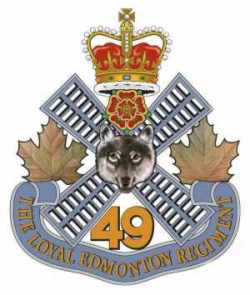Related Research Articles

The 1st Canadian Division is a joint operational command and control formation based at CFB Kingston, and falls under Canadian Joint Operations Command. It is a high-readiness unit, able to move on very short notice, and is staffed and equipped to meet Canada’s military objectives to counter any potential threat.

The 3rd Canadian Division is a formation of the Canadian Army responsible for the command and mobilization of all army units in the provinces of Manitoba, Saskatchewan, Alberta and British Columbia, as well as all units extending westwards from the city of Thunder Bay.

The Canadian Expeditionary Force was the designation of the field force created by Canada for service overseas in the First World War. The force fielded several combat formations on the Western Front in France and Belgium, the largest of which was the Canadian Corps, consisting of four divisions.

The Royal New Brunswick Regiment (RNBR) is a reserve infantry regiment of the Canadian Army based in New Brunswick. The Royal New Brunswick Regiment is part of 37 Canadian Brigade Group, 5th Canadian Division. The RNBR holds 65 battle honours.

The Loyal Edmonton Regiment, or LER, is a Primary Reserve infantry unit of the Canadian Forces based in Edmonton, Alberta. The LER is part of 3rd Canadian Division's 41 Canadian Brigade Group. They are colloquially known as "The Loyal Eddies".

The Essex and Kent Scottish is a Primary Reserve infantry regiment of the Canadian Army.

The 20th Battalion, CEF was a unit of the First World War Canadian Expeditionary Force.

The 207th (Carleton) Battalion, CEF was a battalion of the First World War Canadian Expeditionary Force.

The Queen's York Rangers (RCAC) is a Canadian Army Primary Reserve Royal Canadian Armoured Corps regiment based in Toronto and Aurora. The regiment is part of 4th Canadian Division's 32 Canadian Brigade Group. The regiment consists of one reconnaissance squadron, and the Headquarters and Training Squadron. The regimental family also includes The Queen's York Rangers Band (volunteer) along with two Royal Canadian Army Cadet corps and a Royal Canadian Air Cadet squadron. The unit mottos are pristinae virtutis memor – "remembering their glories in former days" – and celer et audax – "swift and bold." Among its own members and those of other regiments, the unit is referred to as the Rangers. The name is abbreviated as QY Rang, and sometimes pronounced KWY-rang.

The 58th Battalion, CEF was an infantry battalion of the Canadian Expeditionary Force during World War I.
The 27th Battalion, CEF was an infantry battalion of the Canadian Expeditionary Force during the First World War. The battalion was authorized on 7 November 1914 and embarked for Great Britain on 17 May 1915. It disembarked in France on 18 September 1915, where it fought as part of the 6th Infantry Brigade, 2nd Canadian Division in France and Flanders until the end of the war. The battalion was disbanded on 15 September 1920.

The 22nd Battalion, CEF, was a battalion of the Canadian Expeditionary Force in the Great War. It is perpetuated by the Royal 22e Régiment.
The 50th Battalion (Calgary), CEF, was an infantry battalion of the Canadian Expeditionary Force during the Great War. The 50th Battalion was authorized on 7 November 1914 and embarked for Britain on 27 October 1915. The battalion disembarked in France on 11 August 1916, where it fought as part of the 10th Canadian Infantry Brigade, 4th Canadian Division in France and Flanders until the end of the war. The battalion was disbanded on 30 August 1920.
The 18th Battalion, CEF, was an infantry battalion of the Canadian Expeditionary Force in the Great War.

The 25th Battalion, CEF was a unit in the Canadian Expeditionary Force during the Great War. It was the second infantry battalion of ten to be raised in Nova Scotia during the war. The 25th served in Belgium and France as part of the 5th Canadian Brigade, 2nd Canadian Division from 16 September 1915 until the end of the war. Regimental headquarters were established at the Halifax Armouries, with recruitment offices in Sydney, Amherst, New Glasgow, Truro and Yarmouth. Of the 1000 Nova Scotians that started with the battalion, after the first year of fighting, 100 were left in the battalion, while 900 men were killed, taken prisoner, missing or injured.

The 26th Battalion CEF, was an infantry battalion of the Canadian Expeditionary Force during World War I. The 26th Battalion recruited throughout New Brunswick and was mobilized at Saint John, New Brunswick. The 26th Battalion, CEF, is perpetuated by The Royal New Brunswick Regiment.

The 28th Battalion (Northwest), CEF was an infantry battalion of the Canadian Expeditionary Force during the Great War. The battalion was authorized on 7 November 1914 and embarked for Britain on 29 May 1915. It disembarked in France on 18 September 1915, where it fought as part of the 6th Infantry Brigade, 2nd Canadian Division, in France and Flanders until the end of the war. The battalion was disbanded on 30 August 1920.

The 8th Battalion, CEF, also known by the nickname ‘The Little Black Devils of Canada’ was an infantry battalion of the Canadian Expeditionary Force during the Great War. The battalion was authorized on 10 August 1914 and embarked for Great Britain on 1 October 1914. It disembarked in France on 13 February 1915, where it fought as part of the 2nd Infantry Brigade, 1st Canadian Division in France and Flanders until the end of the war. The battalion was disbanded on 15 September 1920.

The 46th Battalion, CEF, was an infantry battalion of the Canadian Expeditionary Force during the Great War. The 46th Battalion was authorized on 7 November 1914 and embarked for Britain on 23 October 1915. On 11 August 1916 it disembarked in France, where it fought with the 10th Infantry Brigade, 4th Canadian Division in France and Flanders until the end of the war. The battalion was disbanded on 30 August 1920.
The York Rangers was an infantry regiment of the Non-Permanent Active Militia of the Canadian Militia. Although the unit was first officially created in 1866, the regiment traces its ancestry and origins as far back to Roger's Rangers of the Seven Years War, the Queen's Rangers of the American Revolutionary War and also the York Militia of the War of 1812. In 1936, the regiment was Amalgamated with The Queen's Rangers to form The Queen's York Rangers.
References
- Meek, John F. (1971). Over the Top! The Canadian Infantry in the First World War. Orangeville, Ont.: The Author.
Photographs of the 127th's Work and their maps from the Amiens Sector are held in the Queen's York Rangers Regimental Museum.